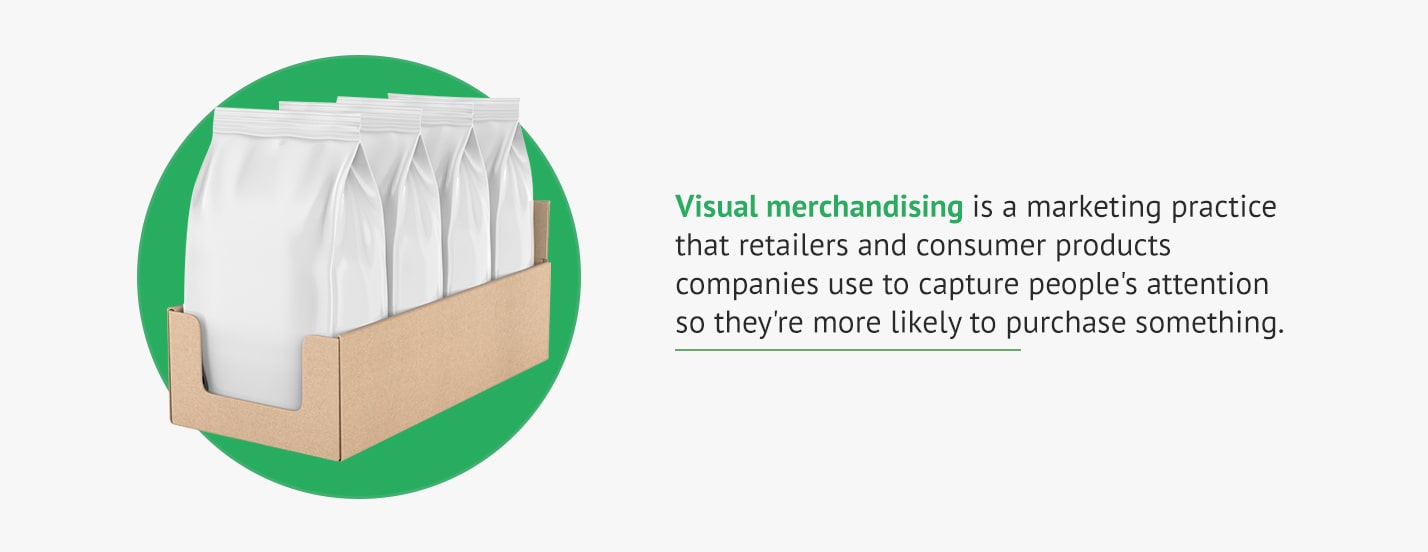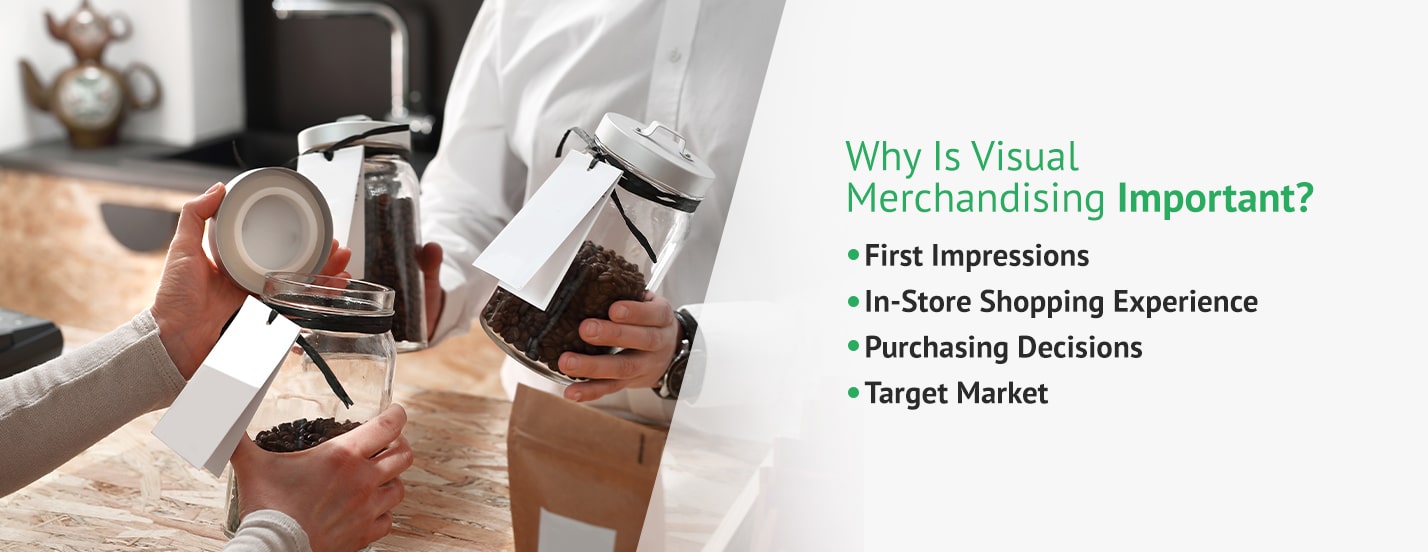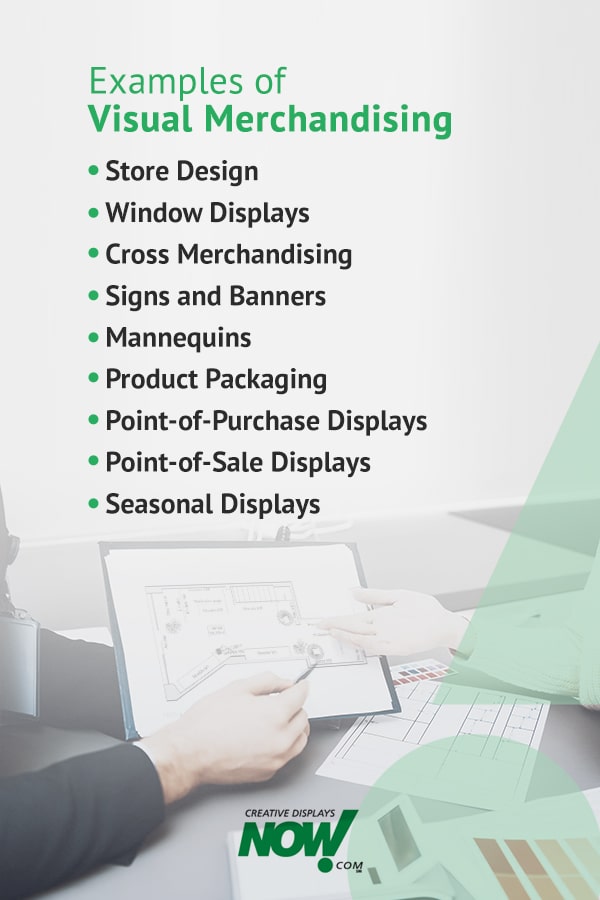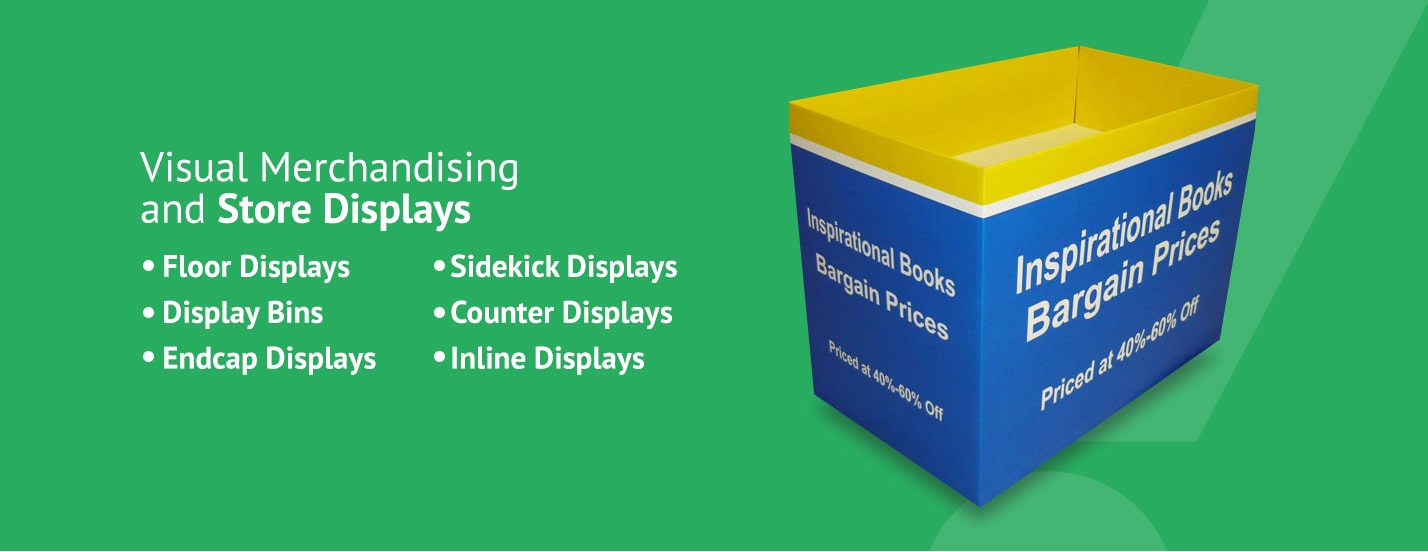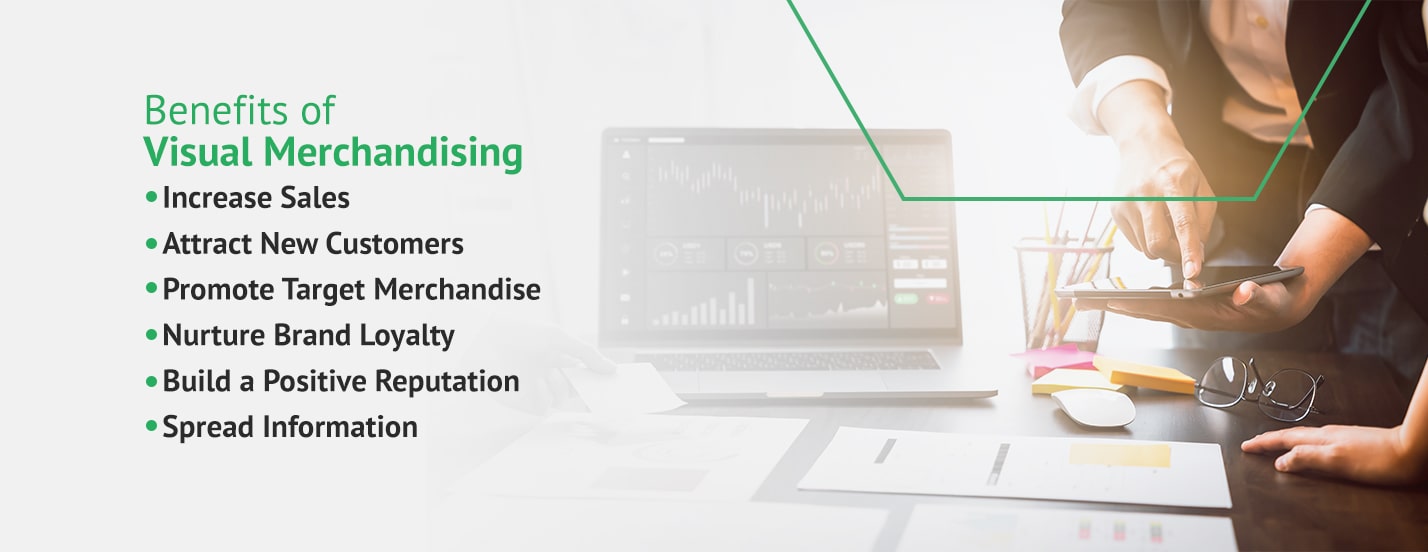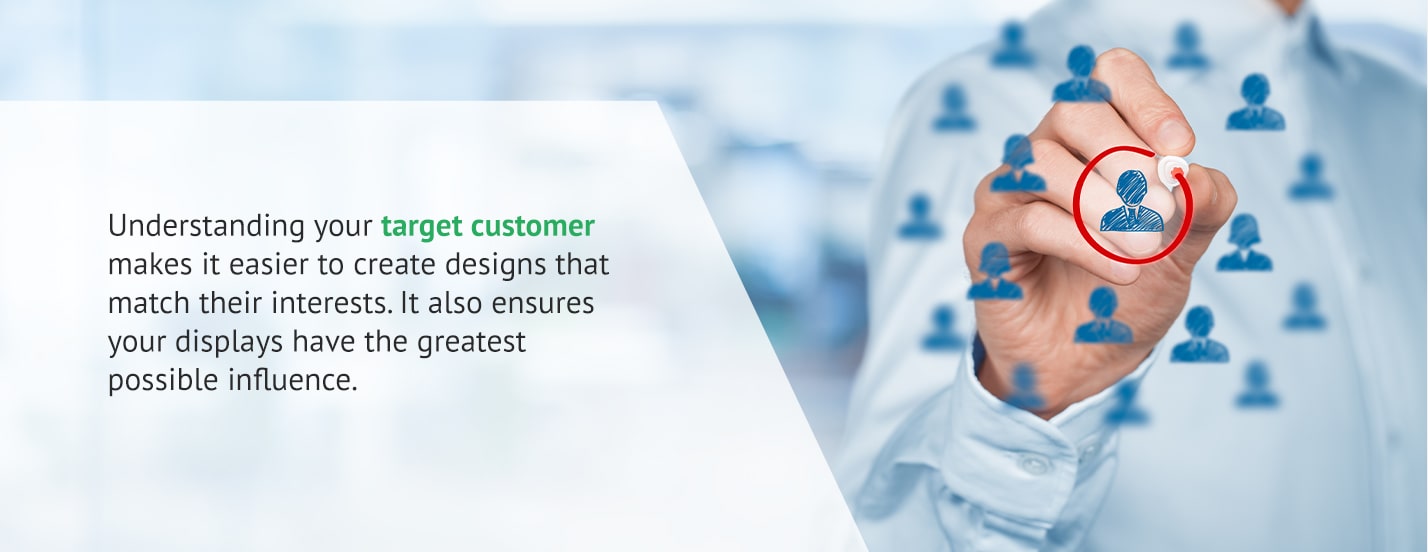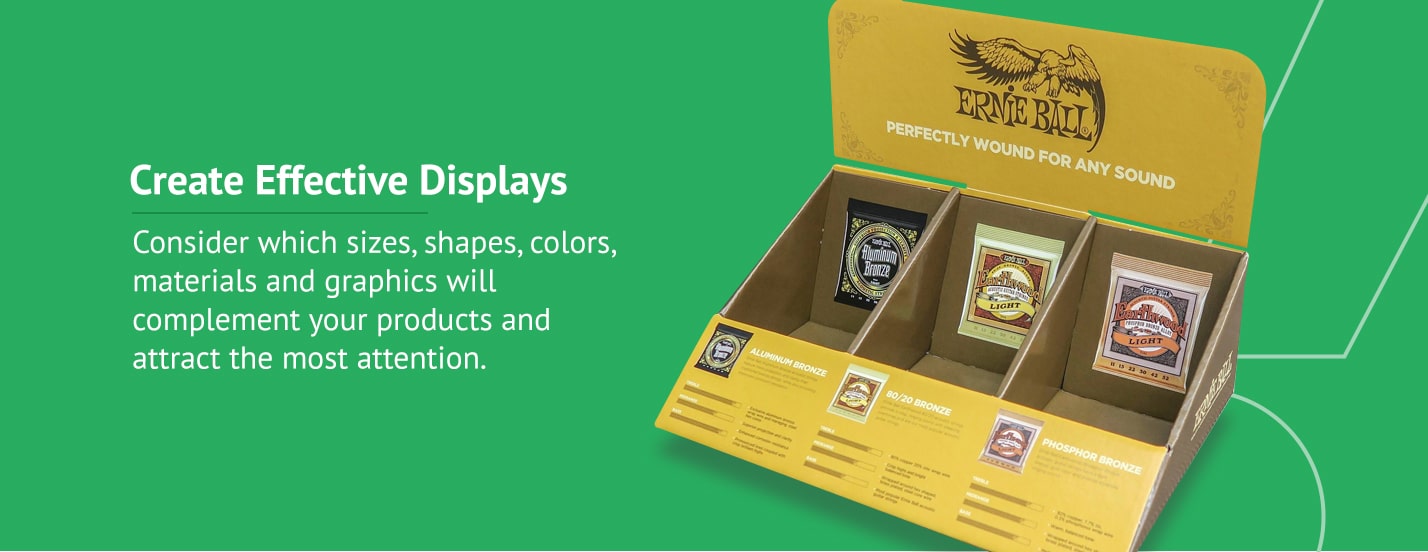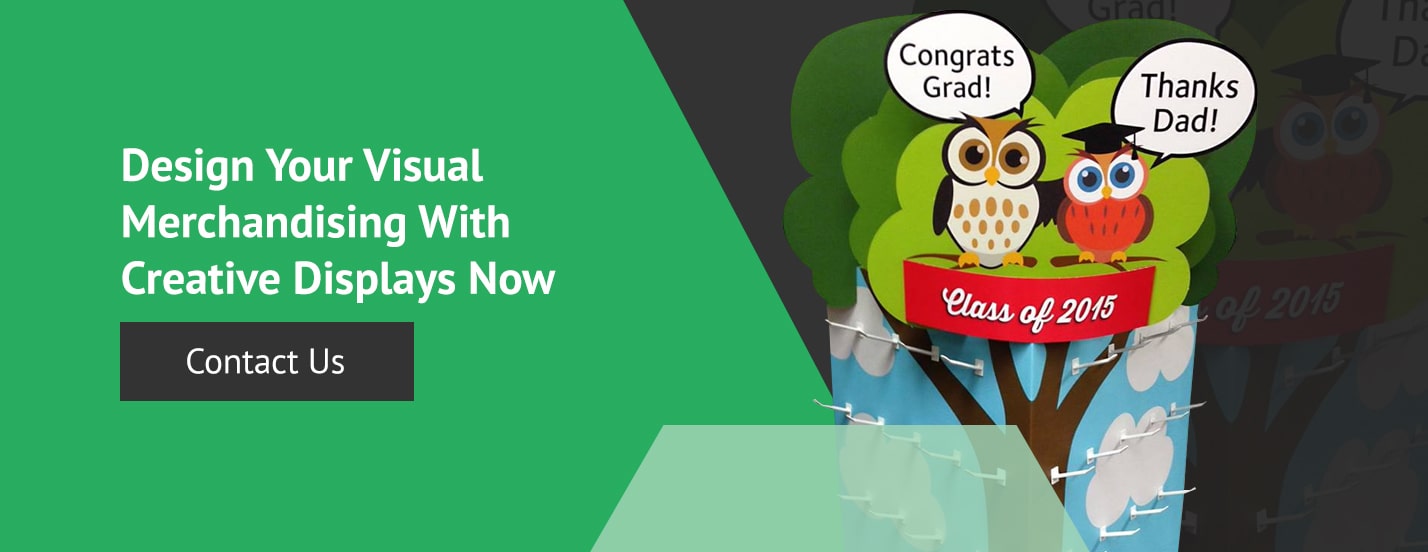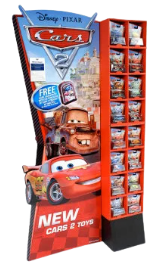From the moment consumers step foot in a store, they start making purchasing decisions based on what they see. The display colors, lighting and messaging play a significant role in which products catch their eye. Using these elements to bring attention to your brand is called visual merchandising. It’s a crucial strategy to make your products stand out in a competitive retail space.
Effective visual merchandising can have a significant impact on your bottom line. This guide will explain what is visual merchandising and how to use it to promote your products.
Table of Contents:
- Visual Merchandising Explained
- Who Uses Visual Merchandising?
- Why is Visual Merchandising Important?
- Examples of Visual Merchandising
- Visual Merchandising and Store Displays
- Benefits of Visual Merchandising
- How to Improve Your Visual Merchandising
Visual Merchandising Explained
Visual merchandising is a marketing practice that retailers and consumer products companies use to capture people’s attention so they’re more likely to purchase something. This practice took off in the 19th century after department store window displays became popular. The initial focus was to attract customers into the store. Since then, the market has become saturated with competition. Now, visual merchandising is an essential strategy that brands use to sell more products inside the store.
Your visual merchandising strategy includes everything customers see as they pass by your merchandise. These elements reflect your mission and tell customers why they should choose your products. Here are some key components to consider:
- Color: Different colors communicate different tones and influence emotions. The colors you choose impact how customers respond to your merchandise.
- Lighting: Including lights in your visual displays can help attract more customers to your products.
- Messaging: The words and phrases you include on your packaging or retail displays significantly impact consumer purchasing decisions.
- Sounds: Modern technology has made incorporating sounds into your retail displays easy. You can play informational messages or songs that express your brand’s personality.
- Scents: Familiar scents can bring back good memories and the positive emotions that go with them. Including a fragrance in your visual merchandising may help consumers associate those same good feelings with your brand.
- Technology: Digital elements are sure to stand out from the competition. You could incorporate an interactive touch screen or promotional video into your retail display.

Visual Merchandising Key Components
Who Uses Visual Merchandising?
Consumer products companies use visual merchandising to promote their goods in a retail space. This approach works for all types of merchandise in any retail category. Brands can use it to sell anything from groceries and beverages to clothing and toys. Many retailers also practice visual merchandising in their stores. They use their knowledge of the space and customers’ shopping patterns to design a layout that boosts sales.
Why Is Visual Merchandising Important?
The ultimate goal of visual merchandising is to sell more products. This method is vital to retailers and consumer goods companies because it can help them make more money. However, wise business leaders prioritize this practice for several other reasons:
1. First Impressions
You have 7 seconds to make a great first impression. In those few short moments, consumers decide whether they’re interested in your products. Investing in creative and original visual merchandising helps you put your best foot forward.
More importantly, visual merchandising catches people’s attention. You can’t make an impression if no one notices your products in the first place. Creating impressive visual displays attracts customers to your brand and promotes a positive first impression.
2. In-Store Shopping Experience
In recent years, online shopping has become increasingly popular amongst consumers. However, e-commerce only accounts for 18% of global retail sales. Consumers still do most of their shopping in physical stores because they enjoy the tactile experience, amongst other benefits. Surveys show that 62% of consumers prefer in-store shopping because they can see and feel the items.
Visual merchandising helps fulfill this need, with eye-catching displays that make it easier for customers to find products that match their interests. Displays make the in-store shopping experience more exciting and enjoyable so customers keep coming back for more. Visual displays also encourage shoppers to test your products and learn more about your brand.
3. Purchasing Decisions
Have you ever gone to the store for one thing and left with an entire cart full of items? Shoppers leave retail stores with more than they intended to buy 75% of the time. Sellers use retail merchandising to influence purchase decisions while shoppers are in the store. They target potential customers during the pivotal moments before they make a purchase.
4. Target Market
There’s no advertisement or branding that will appeal to everyone. Instead, brands focus their attention on consumers with the greatest purchase potential. Brands use visual merchandising to reach customers who are most likely to buy their products. They customize their packaging and displays to appeal to a specific demographic.
Types of Visual Merchandising
What is visual merchandising? It is everywhere. Customers are exposed to it from the moment they open the retailer’s door until it closes behind them. Here are some prime visual merchandising examples:
1. Store Design
A store’s interior design and layout significantly impact the types of customers it attracts and how these people make purchasing decisions. Every detail matters, from the color of the walls to the organization of the merchandise. Furniture stores are designed much differently than grocery stores for good reason.
When choosing a retailer to carry your products, it’s important to consider the types of customers they attract. You want their visual merchandising strategies to align with yours.
2. Window Displays
Window displays are prime real estate for visual merchandising. They’re often the first thing shoppers see. They allow you to start marketing your products before the consumer even enters the store, which is why window displays must be creative and unique.
3. Cross Merchandising
Displaying complementary items together encourages customers to buy more products. For example, think of how retailers often showcase salsa and tortilla chips on the same display. Shoppers are more likely to purchase both items instead of one.
4. Signs and Banners
Signs and banners help shoppers navigate through the store. You can use them to guide customers to your products or highlight special features.
5. Mannequins
Mannequins are ideal for displaying clothing and accessories. They come in different styles, sizes and skin tones to connect with specific audiences. For example, a plus-size clothing manufacturer could display their clothes on a larger-sized mannequin. The type of mannequin and its positioning and styling can tell consumers a lot about your brand.
6. Product Packaging
Packaging is crucial to the success of your visual merchandising. It provides valuable information about your product to influence purchasing decisions. It’s vital that your packaging reflects your brand’s personality and blends with the rest of your marketing materials. You want to send a clear and consistent message to consumers.
7. Point-of-Purchase Displays
Point-of-purchase (POP) displays are fixtures placed throughout the store to showcase a particular product or brand. They’re stationed in high-traffic areas, so customers are more likely to notice that product and add it to their cart. POP displays are typically custom-made in various shapes and styles to promote a specific item.
8. Point-of-Sale Displays
Point-of-sale (POS) displays are often confused with POP displays, but they’re slightly different. A POS display is a promotional fixture placed near the checkout area. This visual merchandising tactic targets consumers while they wait for their turn to pay. POS displays often promote low-cost items that won’t significantly impact the shopper’s total. People are more likely to add these goods to their cart since they’re already making a purchase.
9. Seasonal Displays
Limited-edition products come out every season. Seasonal displays introduce these items and motivate customers to purchase them. They help manufacturers sell more products in a short amount of time.
Types of Display in Visual Merchandising
A major component of visual merchandising is in-store displays. The types of displays in visual merchandising showcase your products away from the shelves, so customers are more likely to notice them and consider purchasing. For developing brands, store displays are crucial to attracting new customers. Established brands use them to highlight new releases or boost sales for a particular product.
The terms POP, POS and seasonal describe different categories of displays. These groups can be broken down even further to explain the individual fixtures that businesses often use. Understanding the different types of displays will help you create a compelling visual merchandising strategy. Here are the most common types that make a significant impact:
1. Floor Displays
The term floor display describes any freestanding unit that promotes a specific product or brand. They’re typically placed in the center of major aisles to attract the maximum amount of attention. They separate your merchandise from shelves loaded with other products, giving you a competitive advantage. You can customize your floor displays with eye-catching graphics that emphasize your visual merchandising and encourage sales.
2. Display Bins
Display bins are large box-like or hexagonal containers you can fill with large quantities of product. The outside of the container provides plenty of space to print striking graphics and persuasive messaging. These containers make it easy for shoppers to quickly grab your products and put them in their cart. Businesses use them to sell candy, movies, bottled soda, snack bags, bouncy balls and many other products.
3. Endcap Displays
An endcap is prime real estate at the end of an aisle where most customers walk to navigate the store. Creating a custom endcap display increases the visibility of your products, which could potentially boost sales. Endcap displays are an excellent way to introduce new or seasonal products that people might overlook on crowded shelves.
4. Sidekick Displays
Sidekick displays or power wings are often paired with endcap displays to implement cross-merchandising. They hang on the side of endcap fixtures to promote add-on items. For instance, you could pair sponges with dish soap or popcorn with DVDs. Sidekick displays place complementary items in one convenient location so customers are more likely to choose your products. It’s much easier to capture people’s attention from a sidekick display than an aisle flooded with competition.
5. Counter Displays
Counter displays are fixtures placed at the point of sale to encourage last-minute purchases. They’re ideal for smaller items that can fit within a limited space. They optimize the time customers spend waiting to check out at the register. Grocery stores and gas stations typically use them for gum, candy, magazines and other impulse items. However, more retailers have started using them to sell jewelry, makeup, perfume, hair accessories and other add-on items.
6. Inline Displays
Inline displays are custom installations brands use to promote their products on retail shelves. They draw attention to your merchandise and highlight its key features.
Inline displays are smaller than other fixtures, but they can make a powerful impact. They target customers who have already made it to your shelf, which means they are probably interested in the type of products you sell. They persuade consumers to choose your merchandise over the competitions’.
Benefits of Visual Merchandising
Any company that sells products in-store participates in visual merchandising. Whether they make an effort or not, customers will see their products and pass judgment on their brand. It’s crucial to take advantage of this opportunity by creating deliberate visual merchandising strategies. Consider these benefits to implementing a visual merchandising campaign:
1. Increase Sales
The main benefit of visual merchandising is increased sales. By making your products stand out, more shoppers will stop and consider buying them. Doing so also reminds existing customers about your brand, making them more likely to make another purchase. It’s like hiring a full-time salesperson to stand in the store and promote your merchandise.
2. Attract New Customers
The first step to attracting new customers is getting them to notice your products. Mesmerizing visual merchandising captures their attention to get your name out there. When they see your brand multiple times, they are more likely to purchase.
In marketing, the rule of seven suggests that you must interact with the customer seven times before they make a purchase. While this number may vary based on the product, it emphasizes the importance of increasing your brand’s visibility and familiarity.
3. Promote Target Merchandise
Some consumer products companies offer a wide selection of merchandise that earns various profit levels. Visual merchandising can help promote targeted items that bring in the most revenue. It also helps showcase seasonal items so you can sell as much as possible within a limited time frame.
4. Nurture Brand Loyalty
Although it’s challenging, earning brand loyalty from your customers is extremely valuable. The key to nurturing these relationships is making every interaction exciting and unique. Visual merchandising makes shopping fun and convenient. When you create a positive experience, customers associate those feelings with your products and are more likely to repurchase them consistently.
5. Build a Positive Reputation
Visual merchandising displays provide an opportunity to communicate with customers about what your brand is all about. Creating consistent messaging about your mission and the products you offer helps spread brand awareness and build a positive reputation with your target market.
6. Spread Information
Another benefit to visual merchandising is highlighting product features and information. Cover your packaging and displays with persuasive messaging that makes your products more appealing than the competitions’. You can also answer questions that may be stopping customers from making a purchase.
How to Improve Your Visual Merchandising Strategy
Your visual merchandising should showcase your products’ features, benefits and appearance so that shoppers feel compelled to purchase them. Plan your retail displays carefully to make the most significant impact. Consider these tips to improve your visual merchandising:
1. Understand Your Target Customer
When you’re trying to design eye-catching displays, it’s important to consider whose eye you’re trying to attract. Are you targeting tech-savvy, environmentally conscious or fashion-forward shoppers? Base your product presentations on what your customers value most.
Understanding your target customer makes it easier to create designs that match their interests. It also ensures your displays have the greatest possible influence. Conduct your own research or analyze existing studies to discover your customers’ interests, needs and motivations. Use this information to plan visual merchandising that will resonate with them.
2. Create a Hook
In retail stores filled with an overwhelming amount of merchandise, customers make rapid decisions about which products are worth their attention. Creating a hook to lure in your target market will give your products the best chance of being noticed. A successful hook is creative, unique and appeals to the senses. Your hook could be something simple like neon packaging or more elaborate like a display that plays music when customers walk near it.
3. Maintain Consistency
Your branding’s tone, messaging and style communicate your mission and personality. Using consistent marketing across all channels helps spread brand awareness. It also makes it easier for customers to recognize your products.
4. Make Frequent Updates
While it’s important to maintain consistent branding, the same old displays will eventually fade into the background. Update your visual merchandising to keep customers interested in your products. Temporary displays allow you to swap out your visual merchandising frequently. Just make sure your updates are cohesive with the rest of your marketing.
5. Follow the Trends
Keep up with industry trends to inspire your latest visual merchandising displays. Doing so shows your audience that your brand is current and innovative.
6. Consider the Retailer’s Requirements
When designing your visual merchandising campaign, you must follow the retailer’s requirements and guidelines. Some retailers restrict your display’s size and shape. For instance, a club store has plenty of room for display bins and large fixtures, while a mom-and-pop retailer may only have space for an inline shelf display.
7. Create Effective Displays
Make the most of your visual merchandising with effective retail displays. Consider which sizes, shapes, colors, materials and graphics will complement your products and attract the most attention. Visual displays that appeal to your customers’ wants and needs can significantly impact your bottom line.
8. Partner With Experts
Give your visual merchandising campaign a boost with help from the experts. Professional designers will assess your products and recommend packaging and displays to spread brand awareness and increase sales.
At Creative Displays Now, we have over 60 years of experience helping our clients create outstanding custom displays. Our talented designers will use their industry expertise and shopper insights to help you promote your products in the retail environment.
Design Your Visual Merchandising Display With Creative Displays Now
Visual merchandising is a crucial tactic that consumer products companies and retailers use to capture their target market and boost sales. Retail displays play a major role in building a successful visual merchandising strategy. Their primary purpose is to help your products stand out, attracting new and existing customers and steering them toward making a purchase. They also help brands spread awareness and establish a positive reputation with their target market.
At Creative Displays Now, our team is dedicated to helping customers create successful retail displays. We have extensive knowledge about all types of displays and how to make them work for your merchandise. We design, print and manufacture your custom displays in-house to ensure they’re made quickly to our quality standards.
Investing time and funds into visual merchandising improves your visibility and profitability. Start by creating custom displays to help your business grow and succeed. We’ll help you personalize the best retail displays and ensure they meet all the major retailer requirements. Call us or get in touch to start today!


